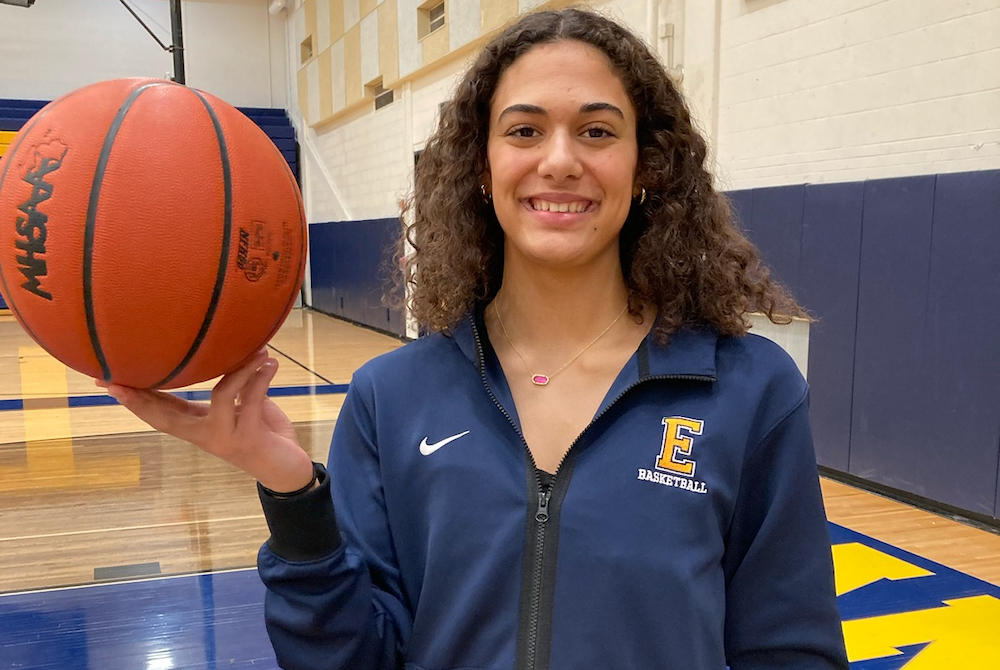
Step by Step, EGR's Brown Climbs to Miss Basketball Award, College Future
By
Steve Vedder
Special for MHSAA.com
March 16, 2023
EAST GRAND RAPIDS – Macy Brown remembers spending her Saturday mornings with her older sisters scrambling around gymnasiums when she was no older than a first grader.
The long and winding journey from those early days to a sterling career at East Grand Rapids is one chronicled by overcoming the gangly body of a middle schooler, surrendering interest in two other sports in favor of basketball, countless hours of AAU, critical advice from two older sisters, a misfortunate accident to a teammate as a junior that necessitated a position switch and eventually to sorting through scholarship offers from a handful of elite college programs.
It's a path that concluded this week with the Pioneers’ point guard not only becoming one of just 1.3 percent of high school players to accept a Division I scholarship, but also being named winner of the prestigious Miss Basketball Award as the state's top senior player.
It's a long way from those weekend mornings to becoming the school's all-time leading scorer, a four-year starter, all-stater and Miss Basketball winner – and a story that Brown says exceeds anything she could have imagined.
"It's been amazing, magical at times," Brown said. "You don't realize how you've spent your time until it's over. There were a lot of sacrifices, but you also gain so much with the relationships you've had through basketball."
The journey started at the East Hills center in Grand Rapids with older sisters Oliva and Jillian, both of whom are currently playing Division I college basketball, and their mother Noelle, who ran an AAU program. It was the first time Macy Brown recalls taking an interest in the sport and began taking stock of what it would take to play basketball at the high school or possibly even college level.
By the time Brown entered middle school, she was all of 5-foot-9 with skills that while encouraging, were far from a guarantee that a long basketball bloodline would be extended by one more daughter. In fact, it was the first time Brown was spotted by EGR coach Troy Hammond, who recalls her as anything but the player who would become the program’s all-time leading scorer with 1,537 points while starting all 86 of the team's games over four varsity seasons.
"She was a tall, lanky kid who was just figuring her body out," Hammond said, "She was a tag-along with her sisters. She was always smiling, a happy-go-lucky kid who loved being in the gym. But I would be lying if I said she would be as good or better than the experiences I had with her sisters. That was no foregone conclusion."
Still, Brown stuck it out and slowly made progress, both mentally and physically. Boosted by advice from her sisters, Brown's on-court talent began to take shape. She also grew about three inches and began hitting the weight room to gain strength. As she entered middle school, she elected to give up lacrosse and soccer to spend more time playing basketball. Armed by having additional time for basketball, she threw herself into even more AAU ball. College coaches who constantly mine the AAU circuit for emerging talent began to notice Brown, who received her first scholarship offer from Loyola of Chicago following her eighth-grade season.
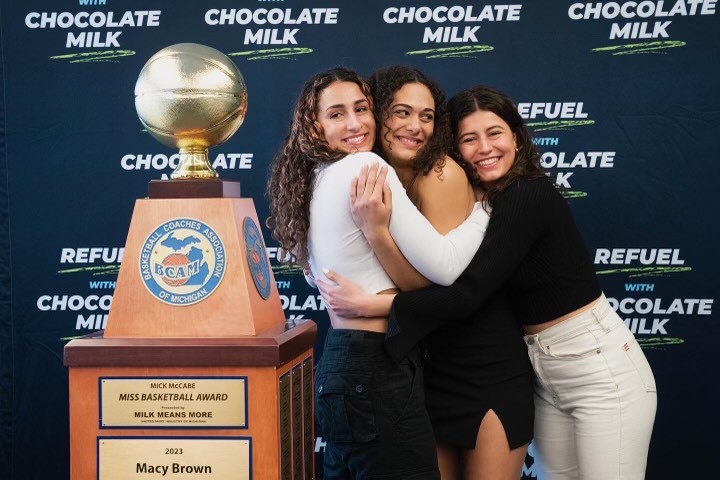 Despite the interest, however, Brown knew she had to become a better player.
Despite the interest, however, Brown knew she had to become a better player.
"I was pretty good, but you don't realize how big of a leap it is from middle school to high school," said Brown, who had no second thoughts about becoming a single-sport athlete. "I grew up around basketball, it was always my first sport. I couldn't see playing lacrosse or soccer past high school."
Brown was good enough to make EGR's varsity as a freshman, She averaged 11.7 points per game in her inaugural season and gained additional attention from playing on a 22-1 team that would have been in contention for a Division 1 title if the season hadn't been cancelled because of COVID-19.
Brown continued to hone her game, averaging 13.5 points as a sophomore. She made all-conference for a second time and also made her college choice: she would become a Michigan Wolverine.
"When you know, you know," she said. "I knew I would wind up at Michigan because when I went other places, I would always compare them to Michigan. It just felt like home."
Brown said she relied on her sisters to know what required her utmost attention during the recruitment period. Olivia started at St. Bonaventure and now plays at Valparaiso, while Jillian is at Northwestern. Both offered crucial advice on how to pick a school.
"It definitely helped playing against them. I would get beat on, but it helped me," Macy said. "It was all for the best because it helped me become a better player."
It was after picking her college that Brown's career took another significant step forward. The Pioneers' senior point guard, Ally Carlson, who now plays at Western Michigan, suffered a season-ending ACL injury before senior-year practice began. The injury meant Brown, who had been a shooting guard her first two seasons, would have to move to point. She had to transition from becoming the team's second or even third offensive option to someone counted on to score points. She responded by averaging 22.4 as a junior and tossing in 25 points per game this season.
"I watched her develop into a leader, both as a person and on the court," Hammond said. "To see that development as a coach, it was wonderful."
Brown's improvement as a player included serious self-reflection. She admits to being the kind of athlete who maps out goals and then isn't satisfied until she reaches them.
"Every year was a checkpoint for me," she said. "I worked hard every offseason, and I would always notice what it took to play the game."
While the book on her high school career closes with the Miss Basketball Award, another door is opened in Ann Arbor. Brown said if she were to speak to a room full of young basketball wannabes, her advice would be simple. Brown was once in their position, and better than anyone else knows what it takes to conquer the next step in moving up the basketball ladder.
"It's definitely step by step, and you have to learn from your experiences," she said. "You make sacrifices, but you can gain so much."
PHOTOS (Top) Macy Brown is this season's Miss Basketball Award winner. (Middle) Brown and her sisters celebrate her award this week. (Top photo by Steve Vedder. Middle photo courtesy of the East Grand Rapids athletic department.)
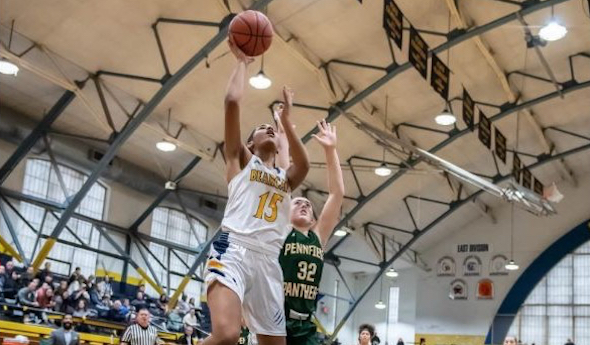
Hoops Finds Annual Home During Holidays
December 27, 2019
By Ron Pesch
Special for Second Half
Nothing says the Holidays like a high school basketball tournament.
It started, like many things do, with a drip. Well, make that a dribble.
The Michigan High School Athletic Association has allowed Holiday basketball tournaments for years. When was the first? That’s hard to establish. No one really kept track of such. A 1934 Wakefield News article indicates that a “Christmas Tournament will be held for the (Gogebic) Range teams at Wakefield December 27 and at Ironwood December 28.” Hurley, Bessemer, Ironwood and Wakefield were entered in the “blind” tournament, with opponents drawn just before game time. It was a new idea, at least in the Upper Peninsula.
“Nothing of its kind has ever been attempted in the Peninsula before,” stated the Ironwood Daily Globe. The tournament, won by Hurley, was a financial success. After expenditures, including the purchase of trophies, profit equaled enough that $22.42 was distributed to each school competing in the tournament. Plans were announced to bring back the tournament in a larger format the following year. It did return the following December, with the same teams in the same format but with all games played in Wakefield. This time out, Ironwood topped Hurley 22-21 for the tournament title.
In the Lower Peninsula in 1935, an All-Berrien County Holiday tournament was held Dec. 26, 27 and 28, with Three Oaks winning the Class B-C division title, 15-13 in the final over Berrien Springs. St. Joseph Catholic emerged as the Class D victor with a surprising 27-26 win over the reigning MHSAA state champ from Stevensville. The 14-team competition was played at Niles High School. Attendance was “slim, very slim” for the opening day of the tourney. The event did not return in 1936.
A similar, but much smaller, event was staged in Berrien County in 1941 with the Bridgman Class C Invitational. The tournament featured seven teams with contests spread over three nights. It was a success.
“Some 450 paid admissions were checked in Wednesday night for the championship finals, which Bridgman won from Berrien Springs. … The total paid admission for the three night event was 1,420 fans with a gross gate of approximately $400.”
By the mid-1940s, the idea of playing prep basketball during the Christmas lull had begun to take off across the state.
In December 1946, before a crowd of 1,500 at the Flint IMA Auditorium, Holland, the reigning Class A champion, downed Flint Northern 51-48 behind a pair of late field goals by Ken ‘Fuzz’ Bauman in the first annual Motor City Invitational. In Jackson, Detroit Catholic Central won the Michigan Catholic Invitational, beating Kalamazoo St. Augustine, 42-40. Bridgman again snagged the title at the Sixth Annual Berrien Class C Christmas Holiday Tournament. It was the Bees’ third Christmas championship in four years. The Little Eight Conference Holiday Tournament was played across four school gymnasiums as the calendar transitioned from 1946 to 1947. Bangor downed Covert, 34-29, in the championship contest hosted at Watervliet High School on Saturday, Jan. 4.
“Holiday tournament basketball has really caught on in Michigan,” said Hal Schram in the Detroit Free Press in 1947. “There will be no Christmas-New Year’s rest for at least 60 Michigan high school squads which have jumped at the chance to sharpen their collective shooting eyes for the long season ahead. … At last count, tournaments will be played between Dec 17 and Jan 3 at Flint, Saginaw, Grand Rapids, Jackson, Lincoln Park, Fremont, Negaunee, Marquette, Benton Harbor and Detroit.”
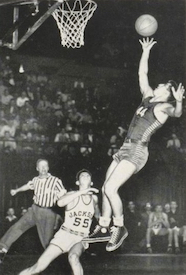 The same eight schools that played at the first Motor City tournament – Jackson, Grand Rapids Central, Holland, Muskegon Heights, Monroe, Midland, Flint Central and Flint Northern – were invited back for the second year. According to Schram, “Not a single participating school of a year ago wanted to be left out.”
The same eight schools that played at the first Motor City tournament – Jackson, Grand Rapids Central, Holland, Muskegon Heights, Monroe, Midland, Flint Central and Flint Northern – were invited back for the second year. According to Schram, “Not a single participating school of a year ago wanted to be left out.”
Jackson downed Flint Northern in the title game, 39-34.
The Saginaw Invitational, hosted at Arthur Hill High School, boasted six Class A schools as well as Alma and Mount Pleasant, both Class B schools. Mount Pleasant surprised the field, winning the tournament with a 40-25 triumph over Dearborn Fordson in the championship game.
A year later in December, Schram wrote, “The Michigan High School Athletic Association wasn’t caught unaware when the tournament bug started to bite every sector of the state.”
“Never did we expect such a wave of tournament play as we will see during the next three weeks,” said Charles Forsythe, state director for the MHSAA, noting 34 Christmas vacation tournaments were scheduled between December 15 and January 8 during the 1948-49 basketball season. “Perhaps we’re lucky at that. The Oklahoma association has had to sanction 123 tournaments.”
Forsythe and Schram explained the reasons for the wave of popularity. Of particular interest was the fact that, at the time, a school sponsoring both football and basketball could play a total of no more than 24 games, combined, in the two sports. However, MHSAA rules allowed a basketball team the chance to play as many as three games during a Holiday tournament and be charged with only one of its allotted combination of 24 contests. (The MHSAA rules changed prior to 1972-73 to allow basketball teams a maximum of 20 games.)
Coaches could keep their squads sharp during the two-week layoff with games rather than just mandatory practices. And, as a bonus to all because tournaments were financed through gate admissions, invitations to larger tournaments meant teams got to “stay and eat at the best hostelries, go on sightseeing tours when not playing and play non-conference opponents from other sections of the state.“
Add in the chance to play before larger-than-normal crowds, and the formula for a successful tournament was cast.
Beginning with the 1950-51 season, the football-basketball rule was altered to count play in mid-season invitational tournaments as two contests. With the change, according to the Detroit Times, “the number of such meets dropped sharply.”
Only nine Holiday tournaments, involving 50-plus teams, were recorded by the MHSAA during the 1951-52 season: the 5th annual Flint Parochial Invitational, the Alpena Catholic Invitational (involving 16 teams), the 5th Annual Greater Lansing Invitational, the Albion College Invitational, the Twin-Five Conference Christmas Tournament (a 10-team replacement for the disbanded Little Eight Conference’s tournament), the Otisville Invitational, the Columbiaville Invitational and the 1st Annual Portland St. Patrick Christmas Invitational.
But by the 1960s, Holiday Tournaments were again regaining popularity, with more now focused on teams from a specific community or section of the state, especially among smaller schools.
The St. Patrick tournament was still going strong in 1966 – its 15th year – with an eight-team, four-day design. Williamston downed a Cinderella squad from Carson City, 64-44, before 1,100 fans at Portland to earn the championship. Other Mid-Michigan holiday tournaments played out in Chelsea and Swartz Creek at the same time.
The Flint Parochial League Tournament was a mainstay of the Holiday season until the breakup of the league in the early 1970s.
“Basketball tournaments have become popular around the state and nation in recent years,” wrote Wendy Foltz, longtime Battle Creek Enquirer sports editor, before the kickoff of the inaugural Battle Creek Central Holiday Cage Tournament in 1968. In a twist that harkened back to earlier days, the eight-team event represented nearly every section of lower Michigan. “Battle Creek never has been a rabid basketball town like some around the state,” added a hesitant Foltz, noting a hope that the event could at least break even.
Hosted at the Cereal City’s historic Fieldhouse, built in 1928, that first tournament was won by host Battle Creek Central, which downed Traverse City 71-53 before a crowd of 2,000. Phil Todd led the Bearcats with 29 points, including 21 in the first half, while 6-foot-8 Tom Kozelko paced TC with 24. Muskegon Heights won the consolation game, holding off a late Ypsilanti Willow Run rally, 78-77. Other schools competing were Battle Creek Lakeview, Grand Blanc, Romulus and recently-opened Jackson Lumen Christi.
Chuck Turner, Central’s head coach, and junior varsity coach Jack Schils had contacted 60 schools during the summer of 1967 to organize the 12-game schedule.
“The response was terrific,” said Schils, who added, “Many schools could not accept because of schedule commitments but want to enter a year hence.”
The Battle Creek tournament was back in 1969, again hosting teams from near and far. Schils noted that cost ran high when teams were brought in from long distances: “However, this type of tournament is highly desirable so we hope fans will support it.”
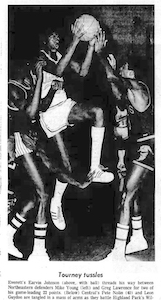
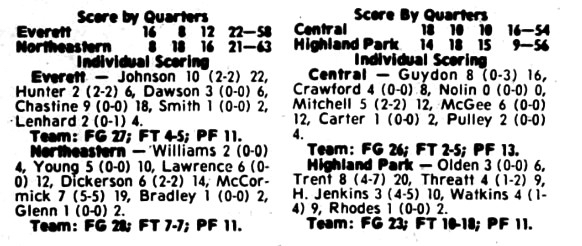 But the event was discontinued following the 1970-71 season when the “eight team format became too unwieldy,” according to the Enquirer “… and both crowd and the quality of play declined.”
But the event was discontinued following the 1970-71 season when the “eight team format became too unwieldy,” according to the Enquirer “… and both crowd and the quality of play declined.”
Pared down to a four-team format, it returned in a big way in December 1975. The tournament saw standing-room-only crowds of more than 3,000 for games between Battle Creek Central, Detroit Northeastern, Class A quarterfinalist Lansing Everett and reigning Class A champion Highland Park.
Detroit Northeastern downed Lansing Everett, 63-58 for the Cereal City championship trophy. Everett junior Earvin Johnson scored 22 points and, with teammate Reggie Chastine, was named to the all-tournament team along with Northwestern’s Wilbert McCormick, the tourney MVP, and his teammate Greg Lawrence. Highland Park’s William Trent and Battle Creek Central’s Leon Guydon also were named to the team.
By the 1980s, it seemed that the Christmas break nearly mimicked March in Michigan.
“I think a Christmas tournament really helps your program,” said Turner in 1980 to the Enquirer. He had taken over the head coaching position at Battle Creek in the fall of 1967 after a successful stint at Willow Run. “I don’t understand basketball teams having a preseason, playing three or four games, then taking two weeks off. When you get back, it’s like starting over.”
Besides Turner’s squad, the 1980 field included Detroit Western, Detroit Murray Wright and eventual winner Kalamazoo Central. The event would ultimately be re-christened the Battle Creek Central Chuck Turner Holiday Classic.
“The late Chuck Turner started bringing big games to the city over the holidays when he first started at the school in the 1960s,” wrote Bill Broderick in the Enquirer in 2018.
“Chuck started this because he wanted to give people the chance to come back home for the holidays and see everyone play. It’s been like a family reunion over the years,” Fred Jones told Broderick. Jones was a longtime assistant to Turner. “That we can keep it going in his name is great and hopefully we can keep if going for another 50 years.”
The girls are now part of the action. All five Battle Creek city schools – Central, Pennfield, Harper Creek, Lakeview, and St. Philip – were part of the event in 2018.
This year the Chuck Turner Central Field House Holiday Classic will again span two days – December 27 and 28 – and will again see all five city schools play on the historic floor.
Other Holiday tournaments scheduled this year include:
Petoskey Invitational – December 13-14
Raider Shootout – December 21
18th Annual Muskegon Area Sports Hall of Fame Classic – December 27
Earl McKee Classic – December 27-28
North Farmington Holiday Extravaganza – December 27
Motor City Roundball Classic – December 27
Cornerstone Invitational – December 27
Washtenaw Hoops Showcase – December 28
 Ron Pesch has taken an active role in researching the history of MHSAA events since 1985 and began writing for MHSAA Finals programs in 1986, adding additional features and "flashbacks" in 1992. He inherited the title of MHSAA historian from the late Dick Kishpaugh following the 1993-94 school year, and resides in Muskegon. Contact him at [email protected] with ideas for historical articles.
Ron Pesch has taken an active role in researching the history of MHSAA events since 1985 and began writing for MHSAA Finals programs in 1986, adding additional features and "flashbacks" in 1992. He inherited the title of MHSAA historian from the late Dick Kishpaugh following the 1993-94 school year, and resides in Muskegon. Contact him at [email protected] with ideas for historical articles.
PHOTOS: (Top) The Battle Creek Central and Pennfield girls face off during the 50th Chuck Turner Classic. (Middle) Shaheen Shaheen scores two points for Flint Northern, which fell to Jackson 39-34 during the 1947 Motor City championship game. (Below left) Lansing Everett’s Earvin Johnson makes a move toward the basket against Detroit Northeastern during the 1975 Battle Creek event. (Below right) Box scores from the 1975 tournament include Johnson’s 22 points in the 63-58 loss. Photos courtesy of the Battle Creek Enquirer, Lansing State Journal and Ron Pesch archives.)

